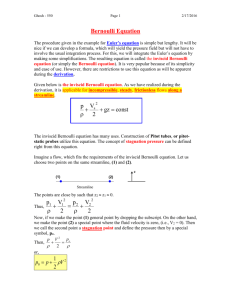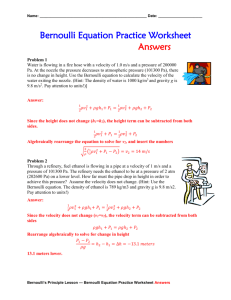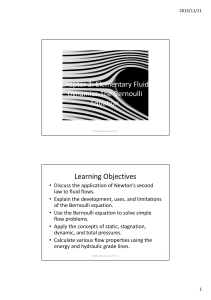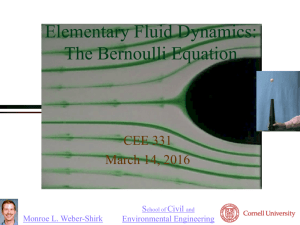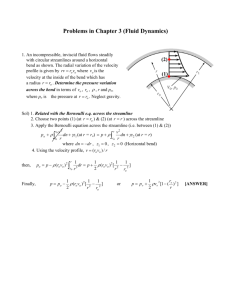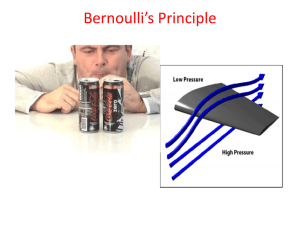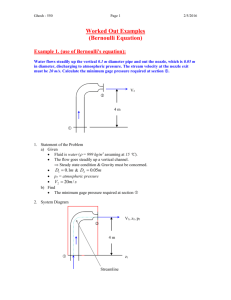Lesson 3 extended
advertisement
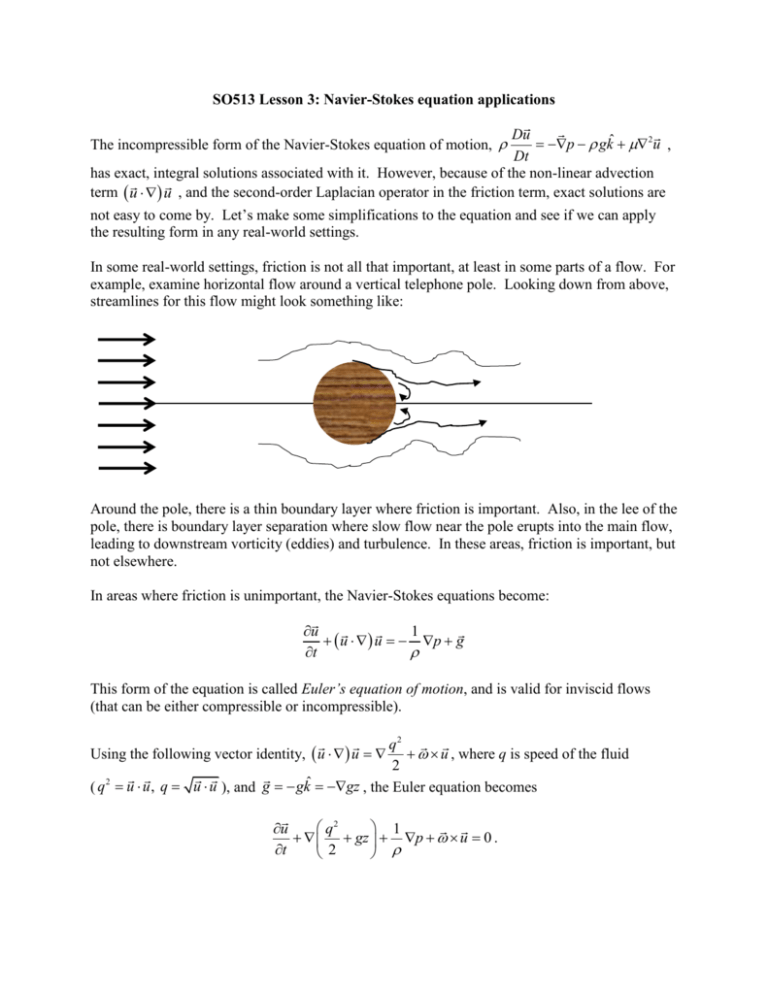
SO513 Lesson 3: Navier-Stokes equation applications Du p gkˆ 2u , Dt has exact, integral solutions associated with it. However, because of the non-linear advection term u u , and the second-order Laplacian operator in the friction term, exact solutions are not easy to come by. Let’s make some simplifications to the equation and see if we can apply the resulting form in any real-world settings. The incompressible form of the Navier-Stokes equation of motion, In some real-world settings, friction is not all that important, at least in some parts of a flow. For example, examine horizontal flow around a vertical telephone pole. Looking down from above, streamlines for this flow might look something like: Around the pole, there is a thin boundary layer where friction is important. Also, in the lee of the pole, there is boundary layer separation where slow flow near the pole erupts into the main flow, leading to downstream vorticity (eddies) and turbulence. In these areas, friction is important, but not elsewhere. In areas where friction is unimportant, the Navier-Stokes equations become: u 1 u u p g t This form of the equation is called Euler’s equation of motion, and is valid for inviscid flows (that can be either compressible or incompressible). q2 Using the following vector identity, u u u , where q is speed of the fluid 2 2 ˆ ( q u u , q u u ), and g gk gz , the Euler equation becomes q2 1 u gz p u 0 . t 2 If density is constant, then 1 p p . If the flow is steady, u 0 . Then the equation t becomes q2 p gz u 0 2 q2 p Dot this equation with a streamline, dr , to get dr gz dr u 0 . dr is 2 parallel to u (by definition of a streamline), so dr will be perpendicular to u . We are left q2 p with dr gz 0 , which is valid along a streamline for an inviscid, constant-density, 2 q2 p steady fluid. The derivation yields gz C , where C is a constant, which is Bernoulli’s 2 Equation for a steady, inviscid, constant density flow. Applications of Bernoulli’s Equation 1. Flow through a restriction (like flow through a channel or a canyon) q2 p gz C . Let the velocity u Uiˆ at the 2 point A far upstream of the constriction. This means the speed at A is U ( qA U ). Bernoulli’s Bernoulli’s equation tell us along a streamline, U 2 pA q 2 p gz A C . At the constriction B, B B gzB C . Since A and 2 2 B are along the same streamline, the constants in the two Bernoulli equations are equal. Thus, U 2 pA q2 p gz A B B gzB . Simplifying the equation (zA = zB), we get 2 2 equation becomes p A pB q 2 2 B U 2 . Since qB U (from mass conservation), we see that p A pB . Bernoulli’s equation has thus told us that the reason the low accelerated from A to B was because of a change in pressure. 2. Horizontal flow around a vertical cylinder (like a telephone pole, or a thunderstorm updraft, which sometimes behaves like a cylinder!) Here upstream flow with speed U approaches the cylinder. The center streamline deflects significantly around the obstacle, while the far-away streamlines experience slight deflection. Point “S” is a stagnation point where velocity goes to zero. At points A and B, because streamlines get closer together, expect velocity to increase. Assume constant density and inviscid, steady flow. Bernoulli equation upstream is U 2 pup gz C 2 At the stagnation point S, pS gz C . The constant C is the same constant because we’re on U2 U 2 pup p , or that the gz S gz . We get that pS pup 2 2 pressure at the stagnation point is higher than it is upstream. At the top (and bottom, by the same streamline. Thus, symmetry) of the cylinder, qB2 pB gz C . Still the same C (the same streamline), so 2 2 2 qB2 pB U 2 pup gz gz . This gives that pB pup U qB , which says that pB pup 2 2 2 2 2 because U qB 0 . 3. Wind storm over a Walmart. q2 p Bernoulli equation along a streamline is gz C . Let’s work with perturbation 2 pressure, the departure of pressure from a mean, background state. p p p0 z . p0 g , or p0 gz . Bernoulli’s equation z q2 p q2 p p0 q2 p gz q 2 p becomes gz gz gz C . Comparing 2 2 2 2 velocity upstream with velocity over the roof of Walmart, we see that the velocity over the roof is much faster (again, because of closer streamlines and mass conservation). This requires a large, negative perturbation pressure, which for a sudden wind storm, will not allow for the Background pressure is in hydrostatic balance, pressure to equilibrate from within the store (which was in hydrostatic balance) and above the roof (which is much smaller). The resulting sudden pressure difference causes the roof to lift off, which immediately equalizes the pressure difference, after which the roof will collapse back into the store. 4. Bernoulli ventilation of prairie dog burrows. Prairie dog burrows have at least two openings, one of which will be elevated. Faster wind speed above the elevated burrow creates a negative perturbation pressure there, when compared to the other opening(s). Thus, pressure gradient drives a slow ventilation flow through the burrow. (Friction within the burrow is probably important, so do not apply Bernoulli’s equation down there). 5. Bernoulli ventilation of underground cities. Similar to prairie dogs, the Hittites built vast underground cities (some up to 20 stories deep!) in the mountains of Turkey. They built ventilation shafts in the mountain side and connected the cities to lateral shafts with outlets at lower elevations. The Taliban had similar structures at Tora Bora, and the Byzantines and Romans also built underground cities.


